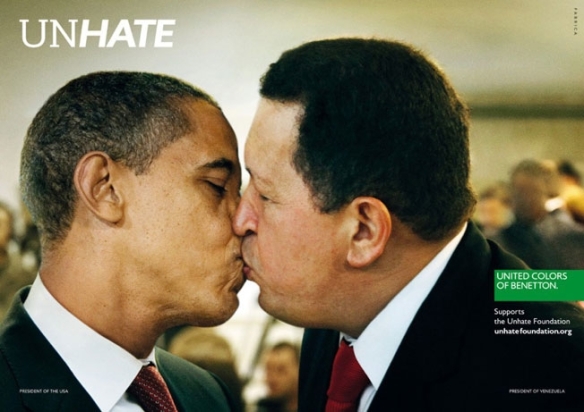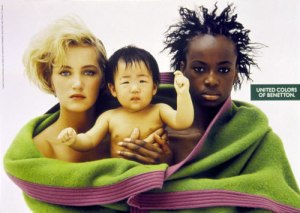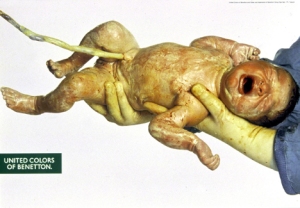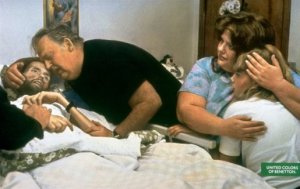
Having just posted about John Hegarty and his view on the state of current advertising (i.e. the ads aren’t good enough). It seems apt to look at the Cannes press Grand Prix winner.
Benetton’s provocative “Unhate” campaign showing world leaders kissing, created by Italian agency Fabrica with help from 72andSunny in Amsterdam got the prize.
Three executions were honored—the ones with U.S. president Barack Obama and Venezuelan president Hugo Chavez; Palestinian president Mahmoud Abbas and Israeli prime minister Benjamin Netanyahu; and German chancellor Angela Merkel and former French president Nicolas Sarkozy.
Absent was the campaign’s most incendiary image—a photo of Pope Benedict XVI kissing a senior Egyptian imam which was pulled almost immediately after the campaign broke last November.
Vatican spokesman the Rev. Federico Lombardi said in a statement cited by The Guardian, after slamming the image as “entirely unacceptable.”
“It is a serious lack of respect for the pope, an affront to the feelings of the faithful and an evident demonstration of how, in the field of advertising, the most elemental rules of respect for others can be broken in order to attract attention by provocation,”
The White House was not amused:
“The White House has a longstanding policy disapproving of the use of the president’s name and likeness for commercial purposes.”
Jury president Tham Khai Meng said that Benetton “has heart impact and gut impact and promotes a global debate”.
Steve Jones, a British juror at the French Riviera event said: “The reason we chose this is because it stood out on the wall… It’s not like traditional advertising. It’s not making a point about the clothes, its brand history. It doesn’t obey the rules.”
- True – but aren’t we judging ads not art and don’t the rules of the sale or effectiveness make it great advertising?
His sentiments were echoed by co-juror Komal Bedi Sohal, from the UAE, who added: “You can like it, you can dislike it, you can’t ignore it.”
- True – but is an arresting image that you can’t ignore the best criteria to judge advertising? Surely any brand could spend the money to publicize an amazing and provocative image, but only a few can make an arresting image that is relevant and sells the product?
The campaign was started in the ’80’s by Oliviero Toscani who was the creative mind behind the controversial work that turned Benetton into a household name.
Toscani was Benetton’s creative director for 18 years from 1982 to 2000. By the height of his success, Toscani was known for his arrogance and drama (and loss of perspective perhaps!), but his first campaign for Benetton in 1982 used teddy bears to model the children’s clothing line. More traditional than you might think.
Twenty-five years ago, Benetton shot to global fame with its controversial line and campaign – all the colors of the world (which became United Colors of Benetton). At the time, whilst controversial, this campaign seemed to reflect the irreverence of the brand as well as the physical nature of the product which featured a wash of primary colours.
The original United Colours was one of the great campaigns, differentiated from the category and relevant to the brand personality and primary product ranges.
Later efforts veered into the weird and wonderful – hearts, lungs, HIV tattoos and just-born babies come to mind.
I would argue that as the campaign veered off a relevant course for the brand (it’s a clothing line and store…), the fortunes of the brand took a nose dive. The figures prove it.
In the ’80’s when Benetton needed to generate awareness amongst a naive public, the notoriety of the campaign had an impact. It then became self-indulgent in the extreme and the company has not recovered.
There were a number of ads featuring HIV in one way or another, such as the famous photo of dying AIDS activist David Kirby taken in his hospital room in the in May 1990, with his father, sister and niece at his bedside. The photograph by Therese Frare, went on to win the 1991 World Press Photo Award, but whether or not this harrowing picture was an appropriate advertising image was widely debated. Some suggested it was more exploitative than supportive with AIDS activists saying that its use in advertising portrayed AIDS in a negative light, spreading fear rather than acceptance. The implied connection between the deaths of David Kirby and Jesus provoked outrage in many markets.
It is therefore very valid to ask if these latest Benetton Unhate ads represent the best on offer in press advertising, or are they just the most extraordinary and provocative campaign in market? If advertising success is measured by sales or by driving foot traffic to Benetton’s franchisees, this strategy and the previous campaigns have not worked.
There is no doubt that advertising remains a delicate blend of art and science. But I don’t agree that the industry is best served by rewarding the sensationalist approach of Benetton when it has lost all relevance to the brand. The Benetton campaign is art / social commentary, not advertising. The ad promises irreverence and a completely different perspective on the world today and all of it’s problems and prejudices that the stores, product and brand experience overall simply fail to deliver.
The judging at Cannes has come in for criticism on a few fronts. I would argue that it needs to return to the basics of effective advertising and the ability to sell a brand to its potential consumer in a relevant way, not just about notoriety, rule breaking or provocation. Great images that can change consumer opinion and sell the product at high return on investment should be recognised and rewarded.
Probably to “dry” for many, but this is actually how the industry survives. By sales.
As John Hegarty said at Cannes, advertising needs to stimulate and solicit the right response in the consumer along the lines of:
“Wow, I want to have a conversation with these people’, as opposed to ‘I’m doing my best to ignore them and they’re doing their best to trip me up in some way or another’. Isn’t that awful, we’re an industry that tries to trick people into watching what we do, why isn’t it inspiring, so people want to watch it.”
Benetton are trying to attract us by provocation rather than inspiration.
To some this might invite interest, particularly amongst social commentators and advertising aficionados, but I think that the shopping majority (and it is a mass market brand) will be confused by the aims of this campaign or potentially confronted by it, not inspired. Challenge and irreverence has a place in advertising, but it needs to be relevant and motivating to the brand.
Benetton Unhate is a great and provocative image, but arguably not a great ad.




